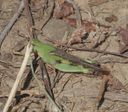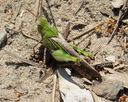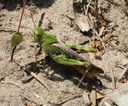Chortophaga
Chortophaga
Classification
- Phylum: Arthropoda
- Subphylum: Hexapoda
- Class: Insecta
- Order: Orthoptera
- Suborder: Caelifera
- Family: Acrididae
- Subfamily: Oedipodinae
- Tribe: Chortophagini
- Genus: Chortophaga
Pronunciation
How to pronounce Chortophaga: /kɔrˈtɔfaɡa/
These audio files are automatically generated. While they are not always 100% accurate, they are a good starting point.
Images






Summary
Chortophaga is a genus of band-winged grasshoppers within the Acrididae family, consisting of species such as the northern green-striped grasshopper and southern green-striped grasshopper. They exhibit a range of colors and patterns, often found in grassy habitats throughout parts of the United States.
Physical Characteristics
Chortophaga species are characterized by a green to brown or tan coloration, sometimes purplish, often displaying two or three large dark bars on the tegmina and longitudinal streaks. The hind femur typically has dark bars, and the hind tibia varies in color, generally appearing brown to green or blue, occasionally purplish.
Identification Tips
Look for large dark bars on the tegmina and a smooth, flatter fastigium of the head. Differences in body size and hind leg characteristics may also indicate differences between Chortophaga and similar genera such as Chimarocephala.
Habitat
Chortophaga inhabits mostly sunny grassy areas, which include meadows, road sides, ditch or stream banks, mountainsides, infrequently mowed lawns, hay fields or pastures, often with bare patches of soil and fine or soft textured grass.
Distribution
Primarily found in the Great Plains and extending into southern coastal states up to the Ohio River Valley and Nebraska. Geographic distinction exists between Chortophaga and Chimarocephala, with species of each occurring in similar areas.
Diet
Primarily feeds on grasses.
Life Cycle
Chortophaga usually overwinters as nymphs, with some adults present in milder southern regions. In northern and western areas, one spring brood is typical, while southern populations may produce two or more broods.
Reproduction
Reproduction occurs through the laying of eggs, which typically hatch into nymphs that develop into adults through a series of molts.
Ecosystem Role
As herbivores, Chortophaga grasshoppers play a role in the ecosystem by influencing plant community dynamics and serving as prey for various predators.
Evolution
Chortophaga is closely related to Chimarocephala, and there is potential for their classification to change as they may be combined into one genus based on geographical and morphological characteristics.
Similar Taxa
Misconceptions
Some species may be misidentified due to overlapping characteristics and the variability of physical traits between populations.
Tags
- Orthoptera
- grasshopper
- Acrididae
- Chortophaga